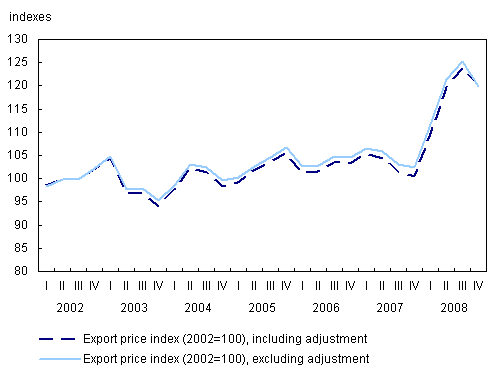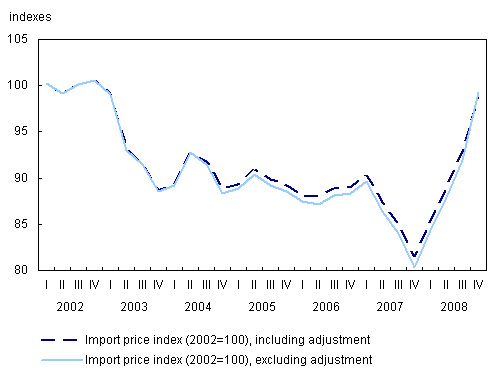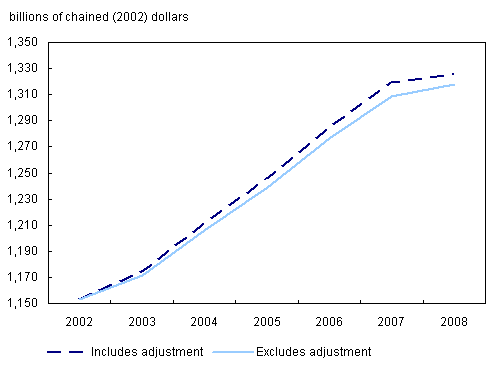Publications
Income and Expenditure Accounts Technical Series
Real Import and Export Adjustments to Account for Exchange Rate Fluctuations
Real Import and Export Adjustments to Account for Exchange Rate Fluctuations
Archived Content
Information identified as archived is provided for reference, research or recordkeeping purposes. It is not subject to the Government of Canada Web Standards and has not been altered or updated since it was archived. Please "contact us" to request a format other than those available.

Background and rationale behind the adjustment
International trade is an integral part of the Canadian economy. Canadian firms ship goods and provide services to export markets while Canadian consumers and firms rely on foreign producers to supply goods and services for final consumption, as well as to provide inputs into domestic production. In 2008 Canadian exports totalled $562 billion, while imports totalled $537 billion, relative to an aggregate gross domestic product of $1,600 billion.
Effectively measuring these transactions is central to monitoring Canada's trade performance and balance of payments, as well as to the derivation of the expenditure-based gross domestic product (GDP) estimate. GDP estimates serve to measure the total value of production in the Canadian economy and the growth in this production over time. This growth measure is derived both in terms of the value at the current prices of produced goods and services, as well as the real or volume growth of this output. The real measure requires the deflation of GDP components which removes price or inflationary effects over the period. The deflation process for international trade statistics relies on dividing the import and export value series by appropriate price indexes to arrive at volume, or real, movements.
Statistics Canada produces monthly import and export merchandise trade price indexes which are used in this deflation. For the majority of these indexes, Statistics Canada uses a variety of proxy measures to derive these indexes in lieu of collecting observed import and export prices. These proxy measures include average prices derived from customs documentation, Canadian domestic prices from Statistics Canada's Industrial Product Price Index (IPPI) program, or U.S. domestic price indexes adjusted for the Canada/U.S. exchange rate. In the case of the latter, 100% of the fluctuation in the exchange rate is applied to the U.S. domestic indexes to arrive at the Canadian import price variation.
These methodologies, therefore, are based on assumptions concerning the relationship between domestic prices, international trade prices and exchange rates. Namely,
- export and domestic prices behave in the same manner
- Canadian importers are subject to the same price changes as U.S. domestic purchasers, denominated in U.S. dollars.
Although these assumptions are reasonable during times of exchange rate stability, a review was triggered by the rapid appreciation of the Canadian dollar, which began in 2002. At that time, imbalances between the supply of goods (production plus imports) and the disposition of goods (consumption, exports, inventories and intermediate use) became apparent. This resulted in differences between expenditure-based and production-based gross domestic product estimates. The result of that research indicated that during times of large exchange rate fluctuations, export and domestic prices behave differently, and that Canadian importers are not subject to the same price changes as U.S. domestic purchasers. Based on this research, Statistics Canada has been adjusting its aggregate estimates of real exports and real imports. These adjustments serve to improve the overall coherence of the real expenditure and real production-based accounts1. The purpose of this note is to explain the methodology behind these adjustments. The impact these adjustments have on estimates of real merchandise trade and gross domestic product is provided in Appendix 1.
Chart 1 Exchange rate
Description for Chart 1

Adjustment to real exports
The adjustment to real exports is based on the analysis of three sets of information.
- A comparison is made between constant dollar exports and the actual quantity2 of units exported. This comparison is performed for a subset of commodities (Appendix 2). The commodities selected for the comparison are relatively homogeneous over time, consistently report quantity information on customs documentation, and are currently deflated using IPPI's (domestic prices). The movements in export quantities are compared with the movements in the constant dollar exports for the same commodities. Divergences between these two series have been found to correlate strongly with exchange rate fluctuations and indicate that in times of Canadian dollar appreciation, growth measured through quantities outpaces the growth of the constant dollar estimate for the same series. The implication is that the constant dollar growth estimate is too low, and that the true export price growth is lower than the price growth of the domestic IPPI when the Canadian dollar is appreciating. When the Canadian dollar is depreciating, the opposite is true. The difference in growth rates between the quantity series and the constant dollar export series (using the domestic IPPI) is used to derive the first component of the adjustment to real exports.
- The second adjustment makes use of directly observed export prices which are available through the Industrial Product Price Index program (IPPI). Although the export prices used to produce these price indexes are not based on an adequate number of price quotes to be published, they are nevertheless analytically useful. For two machinery and equipment commodity prices (industrial machinery and agricultural machinery), the domestic prices are compared to specific machinery and equipment export prices to determine if an exchange rate driven bias exists. The research showed that divergences between the export prices and domestic prices for these commodities are correlated with exchange rate fluctuations.
- Finally, a set of economy wide supply disposition models, as well as extensive coherence analysis between production and export estimates are used as an input into the adjustment to real exports.
Because the supply disposition analysis is focused on total exports rather than specific commodities, and because the results of the commodity level analysis are believed to be more accurate at the aggregate level, the three adjustments are combined together and applied at the aggregated level in the real export series'other balance of payments adjustments'3. The price of the 'other balance of payments adjustments' series is also adjusted as a consequence. The effect of the adjustment on the aggregate merchandise exports price series is evident when comparing the implicit price with, and without, the adjustment.
Chart 2 Merchandise export price
Description for Chart 2

Adjustment to real imports
The adjustment to real imports is derived from three sources.
- The first adjustment is based on the timing difference between when goods imported to Canada were shipped from their country of origin and their date of arrival in Canada. Although imports may have been shipped prior to the month when they arrived in Canada, the current import prices are based solely on the foreign domestic price of the current month. For example, suppose a commodity was shipped in May and should correspond to a foreign price of 100. The commodity arrives in Canada in June, at which point the foreign price has risen to 110. Unadjusted, the value of the commodity would be deflated with the price index of 110. To address this issue, the aggregate import price deflator, excluding energy, is lagged and re-constructed to include 90% of the current month's price, and 10% from the previous month. The 90% to 10% weighting is based on research on transaction level import data, comparing when imports were shipped versus when they arrived in Canada4.
- Further, import prices based on U.S. domestic price indexes assume a 100% pass-through effect of all exchange rate fluctuations. Fixed contracts, or the ability of some foreign producers to take advantage of a strengthening Canadian currency to raise export prices relative to prices charged in their home country, lead to the need to re-examine the 100% pass-through assumption. Based on aggregate supply-disposition analysis of the Canadian economy, as well as analysis of individual import prices, an adjustment has been included which limits this pass-through to 96%.5 As previously mentioned, not all import commodities use foreign domestic price deflators; therefore this aggregate adjustment is applied to only 67% of the total import value. The 67% represents approximately the reliance of import prices on U.S. domestic prices and has been held constant over time.
- A quantity versus constant dollar analysis, similar to that described for exports, and commodity balancing, is performed on the import side to refine the adjustment to total real imports.
Similar to the real export adjustment, these real import adjustments are combined together and included at the aggregated level in the real import series 'other balance of payments adjustments'6. There is an adjustment effect on the aggregate real merchandise imports series, and consequently, the aggregate merchandise import price series. This is evident when comparing the implicit price with, and without, the real import adjustment.
Chart 3 Merchandise import price
Description for Chart 3

Impact on imports, exports and gross domestic product
By comparing real aggregate export and import estimates, with and without these adjustments, we can see the impact on the external trade data. As expected, the adjustments serve to raise real export growth and diminish real import growth during times of Canadian dollar appreciation. Further, the magnitude of the effect on the export or import growth rate is closely related to the magnitude of appreciation or depreciation for that quarter. Given the overall appreciation of the exchange rate from the end of 2002 to 2007, the level of the adjustments also tended to increase over time. However, with the significant currency depreciation in the fourth quarter of 2008, the adjustments served to reduce real export growth, and increase real import growth. The effects on total GDP are less pronounced than those on external trade, but are nevertheless significant in several quarters. The detailed adjustments are provided in Appendix 1.
Chart 4 Gross domestic product
Description for Chart 4

Notes:
- The export volume adjustment was incorporated with the first quarter release of gross domestic product in 2004. The import price adjustment was incorporated in two phases, one in the first quarter of 2007 (included from 2003 forward), and a second in the first quarter of 2008 (included from 2004 forward).
- Quantity as reported on the customs documentation.
- The other balance of payments adjustment nominal value series includes the Balance of Payments Division's estimates of inland freight, as well as adjustments for merchandise trade transactions not captured through customs documentation. Prior to the aggregate trade price adjustment, the export 'other balance of payments adjustments' series is deflated using adjustment-specific prices for inland freight and not captured trade transactions.
- On-going research is preformed to verify the stability of this ratio.
- The estimate of exchange rate pass-through is reviewed each production cycle, based on newly available supply-use data.
- The other balance of payments adjustment nominal value series includes the Balance of Payments Division's estimates of inland freight, as well as adjustments for merchandise trade transactions not captured through customs documentation. Prior to the aggregate real trade adjustment, the import 'other balance of payments adjustments' series is deflated using an inland freight price.
- Date modified:
